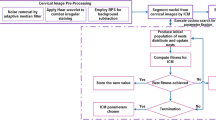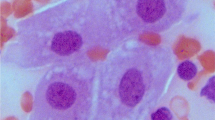Abstract
The objective is to extract the extra space to find the malignant area. The image has been observed and extracted with various methodologies to find the exact nuclei of the cancer cells. Koilocytes cells were taken into consideration of analysis and super pixels segmentation. The malignant cells were found out by extracting and eliminating the background space of the cervical image to get a clear picture of the affected cervical cells. The nuclei cells were segmented to get positive and negative values. The original images were extracted by removing the background spaces and the cytoplasm of the cervical region. The squamous and basal cells were determined by eliminating unwanted cytoplasm. The super pixel cells were taken for the analysis. The method was designed the framework with the series of segmentation and extracting the core nuclei to extract the unwanted space to find the malignant area. Stage 0 explains about the cancer cells find out in the surface of the cervix. More invasive cancers are differentiated into four stages. Stage I—if cancer grows beyond the surface of the cervix and the uterus without affecting the outer region i.e., Walls of the pelvis or the vagina’s bottom surface. Stage II describes the cancer cells has been spread beyond the cervix surface and uterus and possibly to nearby tissue. Stage III cancer considered as a severe type of cancer. The cancer cells were spread to the lower part of the vagina and sometime it will stop the urine flow. Stage IV clearly defines the most advanced stage of cervical cancer. It will affect all the organs of the body. The affected cells were extended to the organs of the human body. The detected malignant cells were divided into segmentation. If the segmentation of each frame contains a malignant cell, then it will be marked as positive and if the frame doesn’t have a malignant cell, then it will be marked as negative. By analysing the segmentation and extraction it can be easily find out the number of malignant cells in the region. In our proposed methodology the original image was undergone into various slides of the Pap smear test. By the positive and the negative values of the core nuclei the growth and the severity of the malignant cells can be pictured. Through the results, the treatment can be easily carried out according to the stages of severity.

















Similar content being viewed by others
Explore related subjects
Discover the latest articles, news and stories from top researchers in related subjects.Change history
14 June 2022
This article has been retracted. Please see the Retraction Notice for more detail: https://doi.org/10.1007/s12652-022-04153-9
References
Bruni L, Albero G, Serrano B, Mena M, Gómez D, Muñoz J, Bosch FX, de Sanjosé S (2019) ICO/IARC Information Centre on HPV and Cancer (HPV Information Centre). Human papillomavirus and related diseases in the world. Summary Report 17 June 2019
Conceição T, Braga C, Rosado L, Vasconcelos M (2019) A review of computational methods for cervical cells segmentation and abnormality classification. Int J MolSci 20(20):5114. https://doi.org/10.3390/ijms20205114
Erkaymaz O, Palabaş T (2018) Classification of cervical cancer data and the effect of random subspace algorithms on classification performance. In: 2018 26th signal processing and communications applications conference (SIU), Izmir, 2018, pp 1–4
Guo P et al (2016) Nuclei-based features for uterine cervical cancer histology image analysis with fusion-based classification. IEEE J Biomed Health Inform 20(6):1595–1607. https://doi.org/10.1109/JBHI.2015.2483318
Hasan MR, Gholamhosseini H, Sarkar NI, Safiuzzaman SM (2017) Intrinsic motivated cervical cancer screening intervention framework. In: 2017 IEEE Region 10 Humanitarian Technology Conference (R10-HTC), Dhaka, 2017, pp 506–509
Hussain SA, Sullivan R (2013) Cancer control in Bangladesh. Jpn J ClinOncol 43(12):1159–1169. https://doi.org/10.1093/jjco/hyt140
Iwai A, Tanaka T (2017) Automatic diagnosis supporting system for cervical cancer using image processing. In: 2017 56th annual conference of the Society of Instrument and Control Engineers of Japan, SICE 2017 (2017-November). Institute of Electrical and Electronics Engineers Inc., pp 479–482. https://doi.org/10.23919/SICE.2017.8105610
Jamil U, Sajid A, Hussain M et al (2019) Melanoma segmentation using bio-medical image analysis for smarter mobile healthcare. J Ambient Intell Human Comput 10:4099–4120. https://doi.org/10.1007/s12652-019-01218-0
Kim KB, Song DH, Woo YW (2007) Nucleus segmentation and recognition of uterine cervical Pap-smears. In: An A, Stefanowski J, Ramanna S, Butz CJ, Pedrycz W, Wang G (eds) Rough sets, fuzzy sets, data mining and granular computing. RSFDGrC 2007. Lecture notes in computer science, vol 4482. Springer, Berlin
Kunos CA et al (2019) Radiopharmaceuticals for persistent or recurrent uterine cervix cancer. Front Oncol. https://doi.org/10.3389/fonc.2019.00560
Lee Y, Bang S (2019) Improved image retrieval and classification with combined invariant features and color descriptor. J Ambient Intell Human Comput 10:2255–2264. https://doi.org/10.1007/s12652-018-0817-0
Madasamy Raja G, Thaha M, Latha R et al (2020) Texture classification using optimized local ternary patterns with nonlinear diffusion as pre-processing. Multimed Tools Appl 79:3831–3846. https://doi.org/10.1007/s11042-019-7197-0
Otero-García MM, Mesa-Álvarez A, Nikolic O et al (2019) Role of MRI in staging and follow-up of endometrial and cervical cancer: pitfalls and mimickers. Insights Imaging 10:19. https://doi.org/10.1186/s13244-019-0696-8
Prabhu V, Kuppusamy PG, Karthikeyan A et al (2018) Evaluation and analysis of data driven in expectation maximization segmentation through various initialization techniques in medical images. Multimed Tools Appl 77:10375–10390. https://doi.org/10.1007/s11042-018-5792-0
Sangworasil M et al (2018) Automated screening of cervical cancer cell images. In: 2018 11th Biomedical Engineering International Conference (BMEiCON), Chiang Mai, 2018, pp 1–4. https://doi.org/10.1109/BMEiCON.2018.8609958
Scarinci IC, Garcia FA, Kobetz E, Partridge EE, Brandt HM, Bell MC, Dignan M, Ma GX, Daye JL, Castle PE (2010) Cervical cancer prevention: new tools and old barriers. Cancer 116(11):2531–2542. https://doi.org/10.1002/cncr.25065 (Review)
Solar M, Peña Gonzalez JP (2019) Computational detection of cervical uterine cancer. In: 2019 Sixth International Conference on eDemocracy and eGovernment (ICEDEG), Quito, Ecuador, 2019, pp 213–217
Walker DC, Brown BH, Blackett AD, Tidy J, Smallwood RH (2003) A study of the morphological parameters of cervical squamous epithelium. PhysiolMeas 24(1):121–135
William W, Ware A, Basaza-Ejiri AH et al (2019) A Pap-smear analysis tool (PAT) for detection of cervical cancer from Pap-smear images. BioMedEngOnLine 18:16. https://doi.org/10.1186/s12938-019-0634-5
Author information
Authors and Affiliations
Corresponding author
Additional information
Publisher's Note
Springer Nature remains neutral with regard to jurisdictional claims in published maps and institutional affiliations.
This article has been retracted. Please see the retraction notice for more detail:https://doi.org/10.1007/s12652-022-04153-9
About this article
Cite this article
Prianka, R.R., Celine Kavida, A. RETRACTED ARTICLE: Extracting the cervical cancer cell region through super pixel segmentation. J Ambient Intell Human Comput 13, 2723–2733 (2022). https://doi.org/10.1007/s12652-021-03259-w
Received:
Accepted:
Published:
Issue Date:
DOI: https://doi.org/10.1007/s12652-021-03259-w




